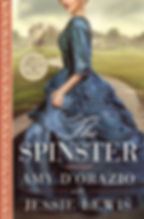By Amy D'Orazio, co-author of The Spinster, Rags to Richmonds Book 2

Being a spinster was an unenviable state for a society where getting married and having children was supposed to be a woman’s primary objective. About one in four gently bred young women nevertheless remained unmarried. Some were unwed due to lack of opportunity and others chose to remain single. Interestingly, the proportion of women who choose to not marry has not changed significantly in the past two centuries.

The term spinster was coined in the mid-fourteenth century to mean a woman who was spinning yarn or thread. Married tradeswomen got the higher-status, better-paying jobs. Unmarried tradeswomen had the less desirable labor. Spinning was considered a less desirable trade because it was difficult, it could be painful for the women’s hands, and it could be physically challenging.
A spinster was not always a slur. The term was used legally since the sixteenth century to mean, simply, a woman over the age of 18 who was unwed. Colloquially, the term gained increasing use for women who were unmarried AND past her prime marrying years—somewhere between 27 and 30. By the Victorian era, calling someone a spinster was seen as extremely insulting.
The terms bachelor and spinster were used in England up into the twentieth-first century. In 2005, the terms bachelor and spinster were both done away with.
Other historical terms of spinsters included old maids, thornbacks (after a flat fish with spines that stung people), superannuated virgins. and ape leaders (from an old proverb that said that a woman’s punishment for remaining unmarried would be to lead apes in Hell).
Most spinsters would reside with a married brother or sister and would be expected to contribute to the household in some way. Spinsters could not live alone or travel alone.

Victorian clergymen preached against becoming a spinster; it began to be seen as a woman with an abnormal sexual appetite (ie, lesbianism) or lack thereof.
An unmarried woman in the 19th century might begin to wear a mob cap at about the age of 29-30. It was also around this time that they would stop dancing at assemblies and parties.
In the late eighteenth century, a tax was proposed which specifically targeted spinsters. Any woman over the age of 27 was to be taxed 6% of the value of her land, property, fortune or other assets. Any woman who failed to accurately report the extent of her financial worth would be required to forfeit 25% of it to the Crown. The proposal was meant to discourage wealthy, unmarried young ladies from electing to remain unwed.

There were many women whose dedication to work or an occupation rather than marriage earned them acclaim. Famous spinsters included Eleanor Coade (1733-1821) the King’s Stonemaker; Caroline Herschel (1750-1848) an astronomer; Mary Parminter (1767-1849) a mountaineer; Maria Edgeworth (1768-1849) an author credited with being the mother of the historical fiction genre; Jane Austen (1775-1817) an accomplished novelist; and Mary Anning (1799-1847) a fossilist. Although it was not in the regency era—or in England—in 1931, an American spinster Jane Addams became the first American woman to win the Nobel Prize.

Often the reason a woman preferred to remain unmarried was because marriage and family would interfere with her ambitions in either occupation or various causes. Many spinsters, for example, joined societies fighting abolition and worked tirelessly to stop slavery both in England and in the United States.
Catharine Sedgwick, an American novelist of the nineteenth century, once wrote, ”We raise our voice with all our might against the miserable cant that matrimony is essential to the feebler sex – that a woman’s single life must be useless and undignified – that she is but an adjunct to man … we believe she has an independent power to shape her own course and to force her own separate sovereign way.”
_____________________
Public Domain Images:
An Encounter at the Spinning Wheel, George Goodwin Kilburne
The Old Maid's Prayer, Thomas Rowlandson and Edward Spragg
An Old Maid on a Journey, James Gillray
An Old Maid and Her Tomcat, George Cruickshank
Catlike Courtship, Thomas Rowlandson

